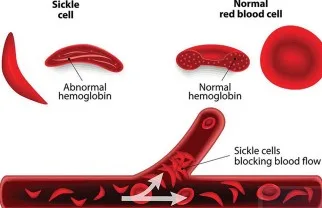Syllabus: GS2/ Health
Context
- India bears the world’s second largest burden of Sickle Cell Anaemia, with over a million people affected by the disease.
What is Sickle Cell Anaemia?
- Sickle cell disease is a hereditary disease caused by mutations in one of the genes that encode the hemoglobin protein.
- If both parents carry the sickle cell trait, the child has significant chances of being born with the disease.
- Sickle shape of cells: While healthy individuals have disc-shaped red blood cells, those with sickle cell disease have red blood cells that take on a crescent or sickle-like shape.
- Impact: This condition leads to shortened red blood cell survival, and subsequent anemia.
- Poor blood oxygen levels and blood vessel blockages in people with sickle-cell disease can lead to chronic acute pain syndromes, severe bacterial infections, and necrosis (tissue death).
- Individuals affected by sickle cell disease are chronically anemic and experience significant damage to their heart, lungs, and kidneys.
- Prevalence: A majority of the patients are concentrated in the tribal belt running across Odisha, Jharkhand, Chhattisgarh, Madhya Pradesh, and Maharashtra.
- Cure: The only cure comes in the form of gene therapy and stem cell transplants. Both are expensive and still in developmental stages.

Measures taken by government
- In 2023, India launched the National Sickle Cell Anaemia Elimination Mission to eliminate sickle cell disease as a public health problem by 2047.
- Hydroxyurea, a vital medicine for treating sickle cell disease, has been included in the essential medicines list to increase access to it.
| National Sickle Cell Anaemia Elimination Mission – The program aims to improve the care and prospects of all sickle cell disease patients while reducing the prevalence of the disease, particularly among tribal populations of the country. 1. It is executed in a mission mode as part of the National Health Mission (NHM). – It will be implemented in 17 high-focus states across namely Gujarat, Maharashtra, Rajasthan, Madhya Pradesh, Jharkhand, Chhattisgarh, West Bengal, Odisha, Tamil Nadu, Telangana, Andhra Pradesh, Karnataka, Assam, Uttar Pradesh, Kerala, Bihar, and Uttarakhand. – Over a period of three years, spanning from the fiscal year 2023-24 to 2025-26, the program targets screening approximately 7.0 crore people. |
Challenges
- Only 18% of the people affected by sickle cell disease in India are receiving consistent treatment.
- This is because patients drop out at all stages of treatment: while getting screened for the disease, while getting diagnosed, while starting treatment, and while trying to adhere to treatment.
- At present, relatively inexpensive drugs such as hydroxyurea are effective for most patients if administered with the right dosage and frequency.
- However, there are challenges in regular supply of medicines.
- In addition to health issues, patients also suffer from the social stigma that is attached to this disease.
Way Ahead
- Reduce Stigma: Raise awareness through targeted media campaigns, drawing from India’s experiences with polio and HIV.
- Expand Screening: Focus on newborn screening, especially in endemic areas, for early detection.
- Improve Accessibility: Ensure medicines and adherence support are available locally, and establish interdisciplinary centers of excellence for complications.
- Increase Vaccination: Implement catch-up vaccination programs for patients to reduce infections.
- Strengthen Tribal Healthcare: Tailor healthcare delivery to tribal areas and ensure sufficient funding for these regions.
Source: TH
Previous article
Growing Concern of Dark Patterns in India’s Digital Landscape
Next article
Universal Basic Income